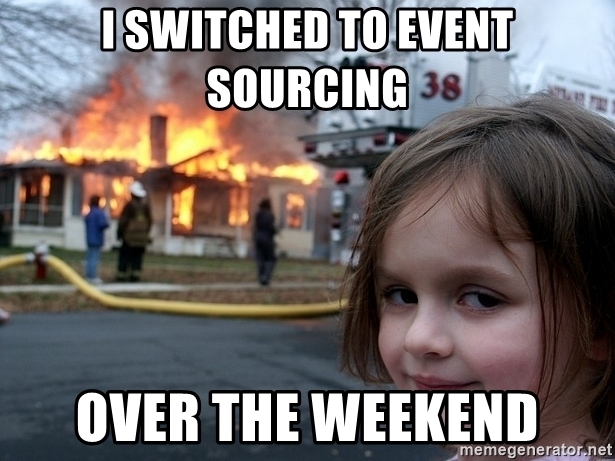Continuing the topic started in the previous post, today’s subject will be related to the domain model with events and why it is important.
So first of all, let’s try to understand what is the “event”?
Domain event describes something, which is happened with the Domain Model and it is important for the domain experts. So let’s revise our domain model:
public class User: Aggregate
{
public Guid Id { get; private set; }
public string FirstName { get; private set; }
public string LastName { get; private set; }
public string Email { get; private set; }
public User(Guid id, string firstName, string lastName, string email)
{
if(id == Guid.Empty)
throw new ArgumentException($"User id could not be empty")
Id = id;
ChangeName(firstName, lastName);
ChangeEmail(email);
}
public void ChangeName(string firstName, string lastName)
{
CheckNullOrEmpty(firstName, nameof(frstName));
CheckMaxLength(100, firstName, nameof(firstName));
FirstName = firstName.Trim();
CheckNullOrEmpty(lastName, nameof(lastName));
CheckMaxLength(100, lastName, nameof(lastName));
LastName = lastName.Trim();
}
public void ChangeEmail(string email)
{
CheckNullOrEmpty(email, nameof(email));
CheckMaxLength(50, email, nameof(email));
var trimmedEmail = email.Trim();
if(!Regex.IsMatch(trimmedEmail, @"\A(?:[a-z0-9!#$%&'*+/=?^_`{|}~-]+(?:\.[a-z0-9!#$%&'*+/=?^_`{|}~-]+)*@(?:[a-z0-9](?:[a-z0-9-]*[a-z0-9])?\.)+[a-z0-9](?:[a-z0-9-]*[a-z0-9])?)\Z", RegexOptions.IgnoreCase))
throw new ArgumentException($"Email {trimmedEmail} is invalid");
Email = trimmedEmail;
}
}So for now, the User domain model has 3 changes (events) which are important to business experts (and developers as well, but let’s talk about that later):
- User Created – event which signalizes that user has been created
- User Name Changed – the event will be raised every time when first and/or last name of the user will be changed
- User Email Changed – the event will be raised every time when using email will be changed
First step is that the events should be created:
public static class Events
{
public static class V1
{
public class UserCreated
{
public UserCreated(Guid userId, string firstName, string lastName, string email)
{
UserId = userId;
FirstName = firstName;
LastName = lastName;
Email = email;
}
public Guid UserId { get; }
public string FirstName { get; }
public string LastName { get; }
public string Email { get; }
}
public class UserNameChanged
{
public UserNameChanged(Guid userId, string firstName, string lastName)
{
UserId = userId;
FirstName = firstName;
LastName = lastName;
}
public Guid UserId { get; }
public string FirstName { get; }
public string LastName { get; }
}
public class UserEmailChanged
{
public UserEmailChanged(Guid userId, string email)
{
UserId = userId;
Email = email;
}
public Guid UserId { get; }
public string Email { get;}
}
}
}From the code above, there are 2 things worth to mention:
- Names of the events use past tense (for ex. UserCreated). Such style underline, that something already happened in the past
- Properties among with the whole object are read-only. Partly it relates to the previous point. If the event is smth which has happened in the past, so it is impossible to change the state of the event. (for instance, we could not change the value of the name in the UserNameChanged event, because
unfortunately,we could not change the things from the past)
So probably now you think it should look like this:
public object ChangeName(string firstName, string lastName)
{
CheckNullOrEmpty(firstName, nameof(frstName));
CheckMaxLength(100, firstName, nameof(firstName));
FirstName = firstName.Trim();
CheckNullOrEmpty(lastName, nameof(lastName));
CheckMaxLength(100, lastName, nameof(lastName));
LastName = lastName.Trim();
return new Events.V1.UserNameChanged(userId: Id, firstName: firstName, lastName: lastName)
}Well, in fact, we could that, but there are a couple of problems in such an approach – from the business point of few, method ChangeName should not return anything. We don’t ask here smth like “GetFullName”, so there is nothing to return after the method was executed.
So let’s fix this concern by introducing private _events property and methods for access to them:
public class User
{
private readonly IList<object> _events = new List<object>();
public ICollection<object> DequeueEvents()
{
var events = _events.ToList();
_events.Clear();
return events;
}
private void Enqueue(object @event)
{
_events.Add(@event);
}
rest of the code ......and the method will stay with the void type :
public void ChangeName(string firstName, string lastName)
{
CheckNullOrEmpty(firstName, nameof(firstName));
CheckMaxLength(100, firstName, nameof(firstName));
FirstName = firstName.Trim();
CheckNullOrEmpty(lastName, nameof(lastName));
CheckMaxLength(100, lastName, nameof(lastName));
LastName = lastName.Trim();
Enqueue(new Events.V1.UserNameChanged(userId: Id, firstName: firstName, lastName: lastName))
}*Small change has to be done in the constructor now, as soon as domain methods enqueue events, we could not reuse them in other methods. So we have to move the validation logic to the common part or create a Value Object (which will not be probably covered in that post series, but I highly recommend getting familiar with this concept in Domain-Driven Design).
So example of usage of the User domain now looks like that:
var user = new Domain.User(Guid.NewGuid(), "testFirstName", "TestLastName", "test@email.com");
var events = user.DequeueEvents();
or
var user = userRepository.Get(id);
user.ChangeEmail("newTest@email.com");
var events = user.DequeueEvents();- UserRepository allows getting users from DB. Later in the course, we will use the Marten Framework and Event Sourcing approach for implementing the User Repository.
- Received events could be used to notify other parts of the application about the changes in the User module (We will cover this in the future post related to Microservice Architecture) or for saving our domain model using Event Sourcing
Introduction to Event Sourcing
So now imagine, that Users in our system could be edited by multiple users, and it is crucial to have a guarantee that we have the full history of changes made in the User domain model. So probably you think that we could just have a history table and catch all events, which User generates, so we could have all the changes regarding the particular user (we will come back to that approach when will be touching the Projections in CQRS topic).
The problem with such an approach is that someone could always change accidentally the data in the database (for instance changing email from test@email.com to newTest@email.com). In that case, there will be a difference between history and actual data.
So if we are publishing domain events after each business change, why we could not use these events as a source of truth for building the domain model state?
So after the User has been created, we raise the UserCreatedEvent which contains all information about the created User. Next, we want to change the user name? No problem, event UserNameChanged has all info about this change. So in fact, we don’t need to save the User domain model state itself, it is only enough to save the current version of this User and a list of the events, which will be used for rebuilding the state.
Let’s take a look on a User model, which could be rebuild from events (without versioning for now):
public class User
{
private readonly IList<object> _events = new List<object>();
public string FirstName { get; private set; }
public string LastName { get; private set; }
public string Email { get; private set; }
public User(Guid id, string firstName, string lastName, string email)
{
Process(new Events.V1.UserCreated(userId:id, firstName: firstName, lastName: lastName, email: email ));
}
public void ChangeName(string firstName, string lastName)
{
Process(new Events.V1.UserNameChanged(userId: Id, firstName: firstName, lastName: lastName));
}
public void ChangeEmail(string userEmail)
{
Process(new Events.V1.UserEmailChanged(userId: Id, email: userEmail));
}
#region Applies
private void Apply(Events.V1.UserCreated @event)
{
Id = @event.UserId;
Apply(new Events.V1.UserNameChanged(userId: this.Id, firstName: @event.FirstName, lastName: @event.LastName));
Apply(new Events.V1.UserEmailChanged(userId: this.Id, email: @event.Email));
Status = UserStatus.Pending;
}
private void Apply(Events.V1.UserNameChanged @event)
{
CheckNullOrEmpty(@event.FirstName, nameof(@event.FirstName));
CheckMaxLength(100, @event.FirstName, nameof(@event.FirstName));
FirstName = @event.FirstName.Trim();
CheckNullOrEmpty(@event.LastName, nameof(@event.LastName));
CheckMaxLength(100, @event.LastName, nameof(@event.LastName));
LastName = @event.LastName.Trim();
}
private void Apply(Events.V1.UserEmailChanged @event)
{
CheckNullOrEmpty(@event.Email, nameof(@event.Email));
CheckMaxLength(50, @event.Email, nameof(@event.Email));
var trimmedEmail = @event.Email.Trim();
if(!Regex.IsMatch(trimmedEmail, @"\A(?:[a-z0-9!#$%&'*+/=?^_`{|}~-]+(?:\.[a-z0-9!#$%&'*+/=?^_`{|}~-]+)*@(?:[a-z0-9](?:[a-z0-9-]*[a-z0-9])?\.)+[a-z0-9](?:[a-z0-9-]*[a-z0-9])?)\Z", RegexOptions.IgnoreCase))
throw new ArgumentException($"Email {trimmedEmail} is invalid");
Email = trimmedEmail;
}
public ICollection<object> DequeueEvents()
{
var events = _events.ToList();
_events.Clear();
return events;
}
private void Enqueue(object @event)
{
_events.Add(@event);
}
private void Process(object @event)
{
Type thisType = GetType();
if (thisType == null) throw new NotSupportedException($"Current this type is null!");
MethodInfo methodInfo = thisType.GetMethod("Apply", BindingFlags.NonPublic | BindingFlags.Instance, Type.DefaultBinder, new [] { @event.GetType()}, null );
if (methodInfo == null) throw new NotSupportedException($"Missing handler for event {@event.GetType().Name}");
try
{
methodInfo.Invoke(this, new[] { @event } );
}
catch(TargetInvocationException ex)
{
ExceptionDispatchInfo.Capture(ex.InnerException).Throw();
}
Enqueue(@event);
}
}So there are a few changes in the User class above:
- All state changes have been moved to the Applys methods.
- The Process method has been introduced. This method use reflection to call correct Apply method based on event type and enqueue events.
- All public domain methods use Process method, to introduce a changes in the model.
So in the previous implementation, the first User changed the state and later raised the event. Now, the User first raises an event, and based on that event, makes changes into its own state.
The next post will describe how to test the Domain Model which is using events.
The latest code base version of the project could be found on Github Org Page.


